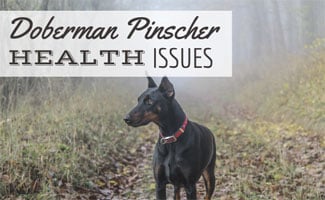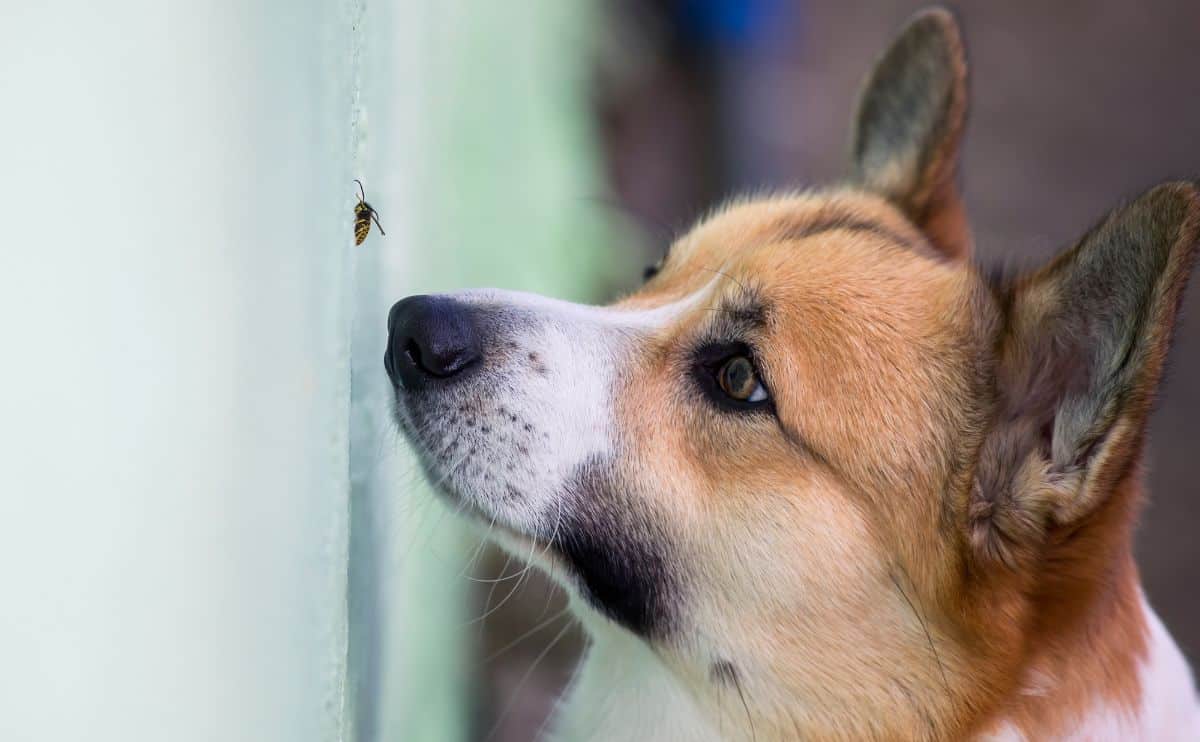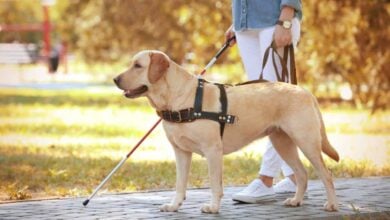Doberman Pinscher Health Issues: Know What To Look For
When you purchase through links on our site, we may earn a commission. Here’s how it works.

The average lifespan of a Doberman Pinscher is 10 to 13 years. While we’d like to see every Doberman Pinscher live 13 years (or beyond), that’s not always the case. Our dogs experience illnesses just like we do, and while some are curable, others can decrease their quality of life or even shorten it. We discuss more about common Doberman health issues.
Table of Contents
7 Common Health Risks For Doberman Pinschers
Below are some illnesses and diseases you should be aware of in case your Doberman Pinscher displays symptoms.
1. Canine Hip Dysplasia (CHD)
Large breeds often have CHD. This chronic condition causes the head of the femur bone to meet with the hip socket incorrectly. Learn More About Canine Hip Dysplasia.
Symptoms
- Pain or discomfort during exercise
- Lameness
- Stiff back legs
- “Bunny hop” like run
- Stiffness getting up or running
- Difficulty getting up
- Muscle tone loss in back legs
- Lack of enjoyment with physical activities that were previously enjoyable
Treatment
Treatment consists of your vet taking an x-ray of the dog’s hip sockets and deciding a course of treatment. In severe cases, dogs may need surgery. Other treatment methods include medications to treat inflammation, weight management, and physical therapy.
2. Dilated Cardiomyopathy (DCM)
Cardiomyopathy is a genetic condition that causes the heart to enlarge. Unfortunately, it usually goes undiagnosed until it is too late and the dog has died. A symptom of cardiomyopathy is difficulty breathing, so if you notice your dog struggling to breathe, you should seek a vet’s care immediately. Dobermans are highly prone to developing this condition. It can cause sudden death due to congestive heart failure.
Symptoms
- Difficulty breathing
- Weakness
- Distention of the abdomen
- Coughing or gagging
- Fainting
- Rapid breathing when sleeping
- Loss of appetite
- Sudden change in attitude, depression, lethargy
Treatment
Treatment will require chest x-rays and imaging, including an ultrasound exam and an electrocardiogram (ECG), to determine how advanced the condition is. Blood and urine tests will be done to test kidney and liver function. Different medications can be used to stabilize function, increase blood flow, manage pain, and make breathing easier. However, DCM is a very serious disease that requires aggressive early treatment. Many Dobermans may live just a few months after diagnosis. Those who respond to treatment can live longer, but there is no cure for DCM.
People often ask, “What do Dobermans usually die from?” Dilated Cardiomyopathy (DCM) is the leading cause of death for the Doberman Pinscher.
3. Demodicosis
Demodicosis, or Demodectic mange, is caused by the mite Demodex canis. Mange occurs when the dog’s skin has too many mites. This type of mange may be localized to one area of the dog and is not contagious. The dog may experience hair loss, pustules, itchy skin, and crusty lesions. Learn More About Demodicosis.
Symptoms
- Hair loss
- Pustules
- Itchy skin
- Crusty lesions
Treatment
Treatment includes medicated baths or oral medications, based on your vet’s recommendation. This can become costly over time. However, you should avoid any home remedies you may find online. These can make the problem worse.
4. Gastric Torsion
Gastric torsion, or canine bloat, is when gas builds up in the dog’s stomach, resulting in it expanding. If the stomach stretches too far, blood circulation to the heart and stomach is cut off, resulting in stomach tissue dying. The stomach can twist at the top and bottom, which stops gas from exiting the stomach. If caught early, the dog can receive emergency care. Unfortunately, canine bloat is most often discovered too late since it is difficult to diagnose. This fatal disease can take a dog’s life within hours, so if you think your dog has bloat, you need to act fast. Learn More About Canine Bloat.
Symptoms
- Change in personality and physical activity level
- The stomach appears larger, distended, and hard
- Lack of normal digestive sounds (place your ear on your dog’s stomach and note if there is any difference)
- Standing in a hunched-over position, unable to get comfortable
- Refuses to lay on their side
- Dry heaving, vomiting foam, or mucus
- Anxious
- Pacing
- Whining
- Licking the air
- Looking at their abdomen
- Standing with their legs spread
- Shallow breathing
- Weak pulse
- Collapsing to the ground
- Cold gums that are dark red (or blue or white in later stages)
- Attempting to defecate but unable to
Treatment
To treat bloat, you must seek veterinary care immediately. The veterinarian will prescribe treatment based on how far the bloat condition has advanced.
If it is early enough that the stomach has not twisted yet, the vet may sedate your dog and place a tube down the dog’s throat. This helps remove gas from the stomach.
If the stomach has already begun to twist, your vet may perform surgery on your dog. The vet will make an incision in the dog’s stomach to help alleviate gas pressure. The stomach may be stapled in place to prevent gastric torsion from occurring again.
Gastric torsion is very serious. If your dog survives it, they should have a complete physical afterward to make sure there is no damage left behind. The removal of any damaged stomach tissue may be necessary to maintain function.
5. Osteosarcoma
Doberman Pinschers may have osteosarcoma, also known as bone cancer. The breed can also develop prostate cancer, mammary cancer, and lymphoma.
Symptoms
- Lumps in various parts of the body
- Swelling
- Lameness
- Joint or bone pain
- Tired
- Anorexia
Treatment
The treatment for osteosarcoma depends on how much the cancer has progressed, the dog’s age, etc. Treatment for all cancers will depend on the type, how advanced it is, and your dog’s health. Ask your vet about treatment options.
6. Von Willebrand’s Disease (vWD)
VWD is a common blood clot disorder that is inherited. It occurs when there is not enough Von Willebrand factor, which is a plasma protein that helps blood clot. VWD can result in severe bleeding, even from a minor scrape. DNA tests are available to help detect this disease early in life.
Symptoms
- Bleeding from the mouth or nose
- Bleeding in the GI tract (dark tarry stools)
- Blood in the urine
- Anemia
- Excessive bleeding
Treatment
Unfortunately, there is no cure for vWD. All you can do is control the bleeding and try to reduce the number of bleeding events.
7. Wobbler Syndrome
Large breeds often have Wobbler Syndrome (also known as cervical spondylomyelopathy), which affects the spine at the neck. Dogs develop a wobbly walk, which is where the name comes from.
Symptoms
- Wobbly gait
- Stiff neck
- Weakness
- Shorter stride
- Weak front limbs
- Partial or complete paralysis
- Muscle loss near the shoulders
- Scuffed nails from uneven walking
- Difficulty getting up
Treatment
Wobbler syndrome treatment consists of your dog’s vet inspecting the location of the spinal compression and determining if surgery is an option. Your vet may suggest bed rest. In this case, you may need to turn your dog from one side to the other every 4 hours to help prevent bed sores. A vet may also insert a catheter to help the dog rest.
If the dog receives medical treatment, expect exercise restrictions for 2 months or more. Complications can arise from surgery that you should discuss with your vet. The vet may suggest post-surgical physical therapy to help the dog recover.
Most Common Health Problems & Symptoms For Doberman Pinschers
Fetch Pet Insurance says of the insured Doberman Pinschers that dilated cardiomyopathy, gastroenteritis, and skin infections are common illnesses. The average costs for these health problems are:
- Dilated cardiomyopathy: $1,794
- Gastroenteritis: $891
- Skin infections: $517
You have the option to pay for these illnesses out of your own pocket, or you can sign your dog up for pet insurance and have it covered. Pet insurance prevents you from having to make the hard decision between saying goodbye to your best friend and going bankrupt. Learn More About Pet Insurance.
Fetch Customer Testimonial For Cardiomyopathy
“As an employee of a veterinary clinic, I knew when I rescued my Doberman 2 years ago that they had a predisposition to a multitude of genetic problems, so pet insurance for my boy was a must. Four months ago, my worst fears came true when he was diagnosed with dilatory cardiomyopathy (heart failure) at only 4 years old. Even with my employee discounts, I knew as a recent college graduate living on a budget, I could never have afforded the medications, ultrasounds, radiographs, and visits to specialists my boy needed without Fetch. Sadly, his disease was a degenerative one & there was very little to do besides keep him comfortable. I wanted the very best treatment I could get him (he deserved only the best!) & pet insurance allowed me to give that. While I miss him terribly, I cannot express how much Fetch Insurance helped me through this difficult time.” – Kristen H.
Doberman Pinschers Are Smart & Make Good Guard Dogs
Doberman Pinschers can be wonderful additions to your family. In fact, Doberman Pinschers are one of the top 10 smartest dog breeds. They are also known to be good guard dogs for families. Just make sure you give them plenty of exercise, and we’re sure you’ll fall in love with them.
Sources: PetMD



